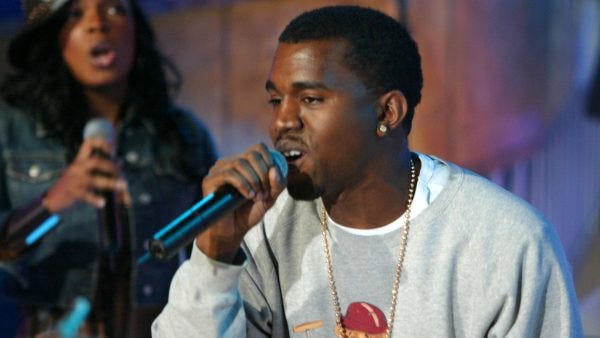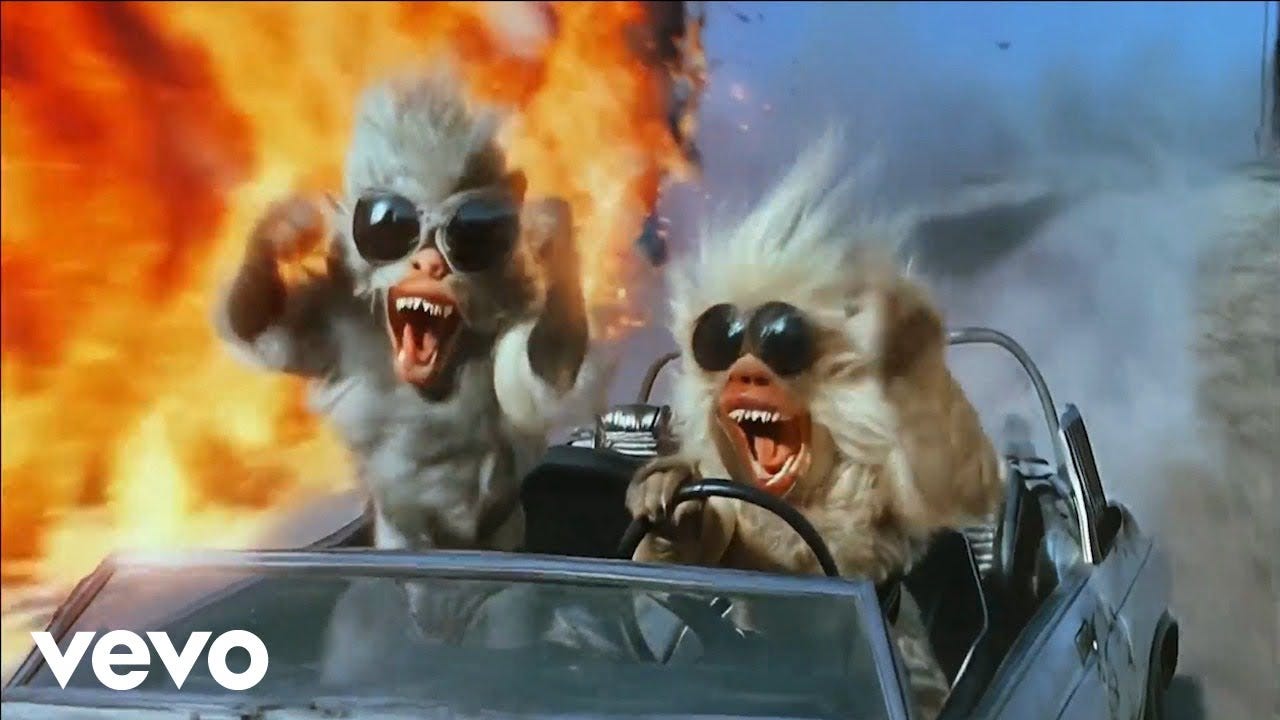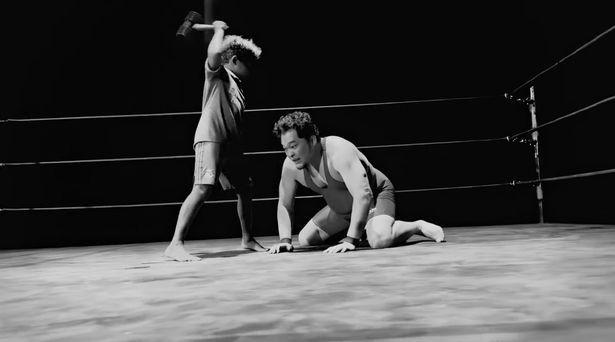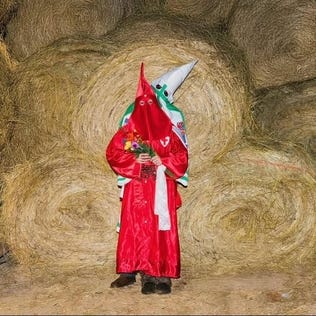There’s nothing to be learned from Bully.
While Ye (the artist formerly known as Kanye West) once offered glimpses into a brilliant, restless mind, his latest visual album—unfinished by his own admission—feels like the byproduct of creative suicide. His multi-day meltdowns on X, marked by bridge-burning, anti-Semitism, and literal porn, gave us a demented peek into an artist consumed by internet degeneracy.
Bully, however, lacks even that ugly intimacy. There’s no trace of human imprint here—just the cold residue of a man who’s surrendered entirely to the void.
Calling something “AI-generated” has become hack criticism, but Ye has embraced the label with unearned pride. “Bomb,” his recent collaboration with daughter North West, featured a nightmarish AI-animated video: half-baked ideas dragged across the screen by lifeless digital puppets. On Bully, Ye doesn’t even bother to record his own voice, letting the computer take over. “Spanish Song” doesn’t feature a single syllable from the man himself—all 1s and 0s. It’s a Ye-Tickle-Me Elmo doll on dying Duracells.
Studio Ghibli mastermind Hayao Miyazaki—whose lifework has been hijacked and trivialized by the latest ChatGPT update (Including the White House and IDF’s official X accounts)—once said AI-generated art was “an insult to life itself.” Since his Nazi-sympathizing spiral in 2022, Ye has shown a similar disdain for life, or at least for the soulful, humanistic touch that once defined his best work.
Every glimpse of the LP’s artistic hope can be crammed into an empty five-minute compilation. As Ye drifts further from any cohesive brand or vision, I’ve lost any faith that he’ll return to—or even finish—his work.
As mentioned, Bully (in its current state) is a visual album directed by hip-hop video extraordinaire Hype Williams. Compared to the AI sludge Ye’s been churning out, it’s a step up. In fact, the visual presentation might be his most coherent and effective artistic statement in years.
Photographed in stark black and white, Bully features Ye’s son, Saint West, gleefully leaping around as he whacks a lineup of Japanese pro wrestlers with a toy mallet. The album’s title was reportedly inspired by a real-life incident in which Saint beat up another kid at school because, in his words, “he was weak.” Ye responded with startled amusement: “This man is really a bully, right here.”
There’s something unsettlingly tender in this bizarre fusion of image and sound—a twisted father-son home movie sprung to life. The striking monochrome visuals—Raging Bull(y) meets home movie—are oddly complemented by Ye’s lo-fi soul chops. Even with a half-finished soundtrack, there’s a hypnotic rhythm to the one-take flow, a dreamlike glimpse into childish chaos that almost recalls the Ye who once had a grip on his own reality.
But it’s fleeting. Whatever joy or creative spark remains is quickly eclipsed. Ye’s work now feels hollow—devoid of personality, inspiration, or basic human curiosity. His once-singular mind, capable of crafting some of the most significant records of the 21st century, now resembles a smooth, gelatinous glop: dulled by pornography, isolation, and alt-right anger. There’s no soul left in the machine.
Ye’s biggest musical idols—Prince and Michael Jackson—were no strangers to being painted as creative eccentrics by the media, but they wielded that image with cinematic flair. Jackson collaborated with masters Scorsese, Coppola, and Lucas to channel his visions of love, culture, and spirituality into kinetic, pop-mythic experiences. Prince’s peak-era discography practically demanded a visual counterpart—Purple Rain, Under the Cherry Moon, and Sign “☮︎” the Times (let’s throw Batman in there too) were all accompanied by films he either directed or spiritually helmed himself.
Ye once flirted with similar ambitions. Projects like My Beautiful Dark Twisted Fantasy were amplified by the short film Runaway, a dreamlike, stylized collaboration with Hype Williams. But even at their lowest moments—artistically or tabloid-wise—Jackson and Prince never plummeted into the pits of misanthropy and hate that Ye now sulks in.
Case in point: just recently, DJ Akademiks aired an interview with Ye wearing a giant glittering swastika chain and black KKK robes. The performance art angle? Nonexistent. (Or maybe Andy Kaufman for losers).
Soon after, Ye dropped a video for “WW3,” a new track whose visuals open with a disturbing edit of a Black man whipping a bound, naked white woman—only to devolve into a montage of interracial porn and climax with a KKK rally and burning cross.
Ye is no Gerard Damiano. He’s not even Burzum at this point. His recent creations aren’t provocations; they’re voids—black holes of affirmation, art drained of anything resembling life as he becomes a master of shock to mask the meaning vacuumed from his being.
Still, so many seem content with keeping Ye’s old music on rotation, guilt-free—as if this new variation of him (let’s call it Kanye West and Ye) was an entirely different entity. And I can’t blame them because, hell, I’m one of them. However, it has gotten to the point where expressing any personal investment in Kanye West feels like an act of pseudo-masochism.
Ye has threatened to drop another album recently, a collaboration with gimmick rapper Dave Blunts. (He’s most known for being obese and having an addiction to the drug-infused beverage Lean.) The teasers are more of the same, amateurishly chopped soul beats as West now mourns the death of his relationship with his second wife, who he’s spent the past two years parading like a Barbie doll a child’s stripped the clothes from.
To nobody’s surprise, nobody cares.
It’s a grim arc: once the most influential figure in modern music, Ye now shuffles along as a hollow imitation, shamelessly biting Tyler, The Creator’s Igor aesthetic for a song that plays like a middle school boy’s apology letter crossed with the “Gary, Come Home” ballad from SpongeBob. The descent feels inevitable—an unending plunge into hate, humiliation, and irrelevance. A pit from which there’s no return, so long as he keeps making soul music without a soul.













